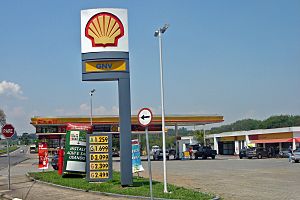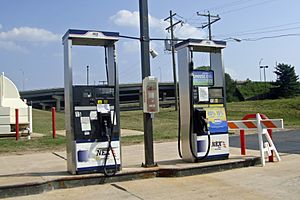Alternative fuel facts for kids

Alternative fuels are special types of fuels that come from sources other than regular petroleum (like gasoline or diesel). They are also called non-conventional or advanced fuels.
These fuels include things like propane, natural gas, methane, and ammonia. They also include biofuels such as biodiesel and bioalcohol. Other alternative fuels are hydrogen and electricity.
The main goal of alternative fuels is to replace fuels that create a lot of carbon dioxide. These include gasoline and diesel. By using alternative fuels, we can help reduce pollution and fight climate change. They also lower other harmful gases from vehicle exhaust. This is very important in places like mines, where bad gases can build up easily.
Contents
What Are Biofuels?

Biofuels are a type of alternative fuel. They are considered a renewable source because they come from living things. While renewable energy mostly makes electricity, some of it is used to create biofuels.
Scientists are always looking for better crops to make biofuels. They also want to find ways to get more oil from these crops. If we wanted to replace all fossil fuels with biofuels, we would need a huge amount of land and fresh water.
Biomass Energy
Biomass is material from living or recently dead plants and animals. It can be used as fuel or for making other products. Many power plants now use biomass instead of coal. This helps them switch to renewable energy without building new plants.
Biomass often refers to plant materials not used for food. It can be burned directly to make heat. Or, it can be changed into different types of biofuel.
Algae Fuel
Fuels made from algae have been talked about a lot. People hope they can solve problems with crude oil for transportation. Algae can produce over 2,000 gallons of fuel per acre each year. The U.S. Navy is already testing fuels made from algae.
Algae can also be used to make plastics. These algae-based plastics could help reduce waste. They are also expected to be cheaper than traditional plastics.
What is Biodiesel?
Biodiesel is a fuel made from animal fats or vegetable oils. These oils come from plants like soybeans, sunflowers, corn, and palm. They are renewable resources.
To make biodiesel, these fats or oils are cleaned. Then, they are mixed with an alcohol like methanol. This chemical reaction creates diesel fuel. Biodiesel can be mixed with regular diesel in different amounts, or used alone. It burns more cleanly and efficiently than regular diesel. This means it releases fewer pollutants like carbon monoxide and harmful particles.
Ammonia as a Fuel
Ammonia (NH3) can also be used as a fuel. For ships, using ammonia can help reduce greenhouse gas emissions. Scientists are studying how to use ammonia in fuel cells and engines. They are looking into changing ammonia into nitrogen and hydrogen gas.
Ammonia is a simple molecule that carries hydrogen in liquid form. It does not contain carbon. It can be made using renewable energy. Ammonia might become a common fuel soon because it is easy to store and move around.
Emulsion Fuel
Diesel fuel can be mixed with water to create an emulsion fuel. This mixture can make engines work better. It also helps reduce the amount of harmful gases released from the exhaust.
Carbon-Neutral Fuels
Carbon-neutral fuel is a special type of synthetic fuel. This includes fuels like methane, gasoline, or jet fuel. They are made using renewable energy or nuclear power. These fuels use carbon dioxide that is recycled from power plant exhaust or from seawater.
These fuels are called carbon neutral because they do not add more greenhouse gases to the air. If they replace fossil fuels, or if their carbon is captured when burned, they can even remove carbon dioxide from the atmosphere. This helps clean the air.
These fuels can be made by using electricity to split water into hydrogen. This hydrogen is then used to make methane. This methane can be stored and burned later in power plants. It can also be sent through pipelines or used to make other transportation fuels.
Carbon-neutral fuels can help store energy from wind power and solar power. This is important because wind and solar power are not always available. These fuels can also be sent through existing natural gas pipelines. This means we might not need to change all vehicles to run on electricity or hydrogen.
Germany has built a plant that makes synthetic methane. Audi also has a plant that makes carbon-neutral liquefied natural gas (LNG). This LNG is used in their cars and helps keep CO2 out of the environment.
The cheapest way to get carbon for these fuels is from power plant exhaust. It costs about $7.50 per ton. Getting carbon from seawater costs more, around $50 per ton. Capturing carbon from the air is even more expensive and not practical for making fuel.
Nighttime wind power is often the cheapest electricity source for making fuel. This is because wind often blows more at night. The price of nighttime wind power can be very low. Companies believe they can make fuel cheaper than petroleum if oil costs more than $55 per barrel. The U.S. Navy thinks making jet fuel on ships using nuclear power would cost about $6 per gallon. This is cheaper than the cost of delivering fuel to a ship.
Hydrogen and Formic Acid
Hydrogen is a very clean fuel. When hydrogen burns, it mostly produces water. However, some nitrogen oxides (NOx) can be made if it burns with air.
Another fuel is formic acid. This fuel is first changed into hydrogen, which is then used in a fuel cell. Formic acid is much easier to store than hydrogen.
Hydrogen/Compressed Natural Gas Mixture
HCNG (or H2CNG) is a mix of compressed natural gas (CNG) and a small amount of hydrogen. Hydrogen can also be used as hydroxy gas to help diesel engines burn fuel better. Hydroxy gas is made by splitting water using electricity.
Compressed Air
A compressed air engine is an engine that uses compressed air as fuel. It does not produce any emissions.
Propane Autogas
Propane is a clean-burning, high-performance fuel. It comes from many sources. It is also known as LPG (liquefied propane gas) or Autogas. Propane is a type of hydrocarbon fuel, similar to natural gas.
Propane used in cars is much like gasoline. But it creates less pollution from the tailpipe and overall. Propane is the most popular alternative fuel in the world. It is easy to find, can be stored as a liquid at low pressure, and has a great safety record. It also costs less than traditional fuels.
Propane has a high octane rating, which means it burns very well. When propane is injected as a liquid into an engine, it cools the cylinder. This makes the engine more efficient.
Propane does not have many additives. This means it produces fewer exhaust gases. It also burns more completely, which means less pollution and longer life for engine oil.
Propane autogas is made when natural gas and oil are produced. It is also a byproduct of oil refining. This means there is a good supply of propane.
Propane is stored and moved as a liquid at about 5 bar of pressure. Filling a car with propane is as fast as filling with gasoline. Propane stations do not need expensive, slow compression systems like those for compressed natural gas (CNG), which is stored at over 3,000 psi.
Cars can be changed to run on propane autogas. This can save money on fuel and lower emissions. It is also efficient because there is already a large network of propane fueling stations.
Compressed Natural Gas (CNG)
Compressed natural gas (CNG) and liquefied natural gas (LNG) are two cleaner fuels that can replace liquid fuels in cars.
Types of Compressed Natural Gas
CNG vehicles can use both renewable and non-renewable CNG.
Regular CNG comes from natural gas found underground. New ways of drilling have greatly increased the supply of natural gas.
Renewable natural gas, or biogas, is a methane-based gas. It is similar to natural gas and can be used as fuel. Biogas mainly comes from landfills, sewage, and animal waste. It can be made through a process called anaerobic digestion, or collected from landfills and cleaned.
How Practical is CNG?
Around the world, over 5 million vehicles use CNG. In the U.S., more than 150,000 vehicles use it, and this number is growing fast.
Nuclear Power and Radiothermal Generators
Nuclear Reactors
Nuclear power uses controlled nuclear reactions to create energy from atomic nuclei. Today, the main method uses nuclear fission in a nuclear reactor. This heats a liquid, which creates steam to generate electricity or power ships. More than 15% of the world's electricity comes from nuclear power. Over 150 naval ships are powered by nuclear reactors.
In theory, electricity from nuclear reactors could power spacecraft. Some small reactors are designed to turn nuclear energy directly into electricity. These are useful for space missions. The Soviet Union and the U.S. have used nuclear reactors in uncrewed satellites.
Thorium-Fueled Nuclear Reactors
Thorium-based nuclear power reactors are also being studied. Many scientists support them. Thorium is 3 to 4 times more common than uranium in nature. Its ore, monazite, is often found in sands near water. Thorium might be easier to get than uranium. Uranium mines are underground and dangerous, but thorium is taken from open pits. Countries like Australia, the United States, and India have enough thorium to power the Earth for thousands of years.
However, thorium reactors can still produce radioactive waste that needs to be stored for a very long time.
For a list of experimental and presently-operating thorium-fueled reactors, see thorium fuel cycle#List of thorium-fueled reactors.
Radiothermal Generators (RTGs)
Radioisotopes have also been used as alternative fuels on land and in space. Their use on land is decreasing because of the risk of theft or environmental damage.
In space, the decay of radioisotopes creates heat and electricity for many space probes. This is especially useful for probes going to outer planets where sunlight is weak. Radiothermal generators (RTGs) use these radioisotopes. They do not have a nuclear chain reaction. Instead, they make electricity from the decay of a radioisotope that was made on Earth as a concentrated power source.
See also
 In Spanish: Combustible alternativo para niños
In Spanish: Combustible alternativo para niños
- Alcohol fuel
- Alternative fuel cars
- Alternative propulsion
- Biogas
- Compressed-air vehicle
- E-diesel
- Energy development
- Fischer–Tropsch process
- Greasestock – An alternative fuel festival in New York
- Heating value
- List of energy topics
- Magnesium injection cycle
- Natural gas hydrate — A possible future alternative to LNG for transporting natural gas
- Monopropellant fuels
- Swiftfuel — A potential lead-free alternative to 100LL aviation gasoline.
- Vegetable oil fuel


